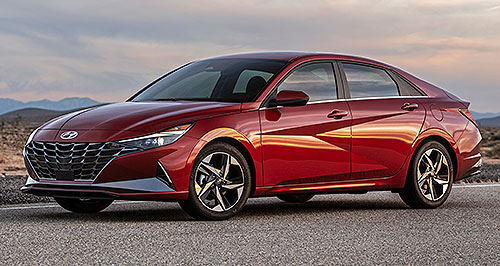Future models - Hyundai - i30 - SedanHyundai reveals all-new i30 sedanElantra bows out as Hyundai Australia turns redesigned model due soon into i30 sedan18 Mar 2020 By TERRY MARTIN HYUNDAI has uncovered its striking new-generation small sedan in the United States, which for Australia will switch nameplates from Elantra to i30 when it arrives here early in the third quarter of this year.
Unlike Japanese rivals such as Toyota’s Corolla and the Mazda3, the South Korean brand’s i30 four-door sedan does not have an immediately familiar front-end design that integrates smoothly with its hatch counterpart, with the recently unveiled facelifted five-door version an altogether different-looking vehicle.
Described as having a “dramatic four-door coupe look” and a “disrupter spirit” with a design theme dubbed Parametric Dynamics, the booted i30 is clearly targeted at the North American market where it was unveiled this week in Hollywood, California.
Compared to the current Elantra, this seventh-generation compact sedan is built on Hyundai/Kia’s K3 platform and has a longer wheelbase, wider stance and lower roofline.
The wheelbase is now 2720mm long (+20mm) and the vehicle’s 4676mm overall length and 1826mm width are up 56mm and 25mm respectively, while overall height drops 20mm to 1415mm.
This makes the i30 sedan longer, wider and lower than key rivals such as Corolla and Mazda3, and Hyundai is quick to emphasise that although the designers – working to these dimensions and with a front cowl point moved back almost 51mm – were allowed to make dramatic changes to the shape of the car, most key interior dimensions have in fact increased.
These include front legroom, shoulder-room and even headroom despite the lowered roofline (when not including a sunroof), a lower seating position contributing here, while in the rear compartment there is more legroom and shoulder space and the same amount of headroom as the current model.
That said, boot space is now listed at 402 litres with the rear seats in place, which is well down on the current model’s 458L.
The new generation brings expected advancements in areas such as powertrain, dynamics, safety equipment and infotainment technology.
Hyundai Motor Co Australia has advised that local specifications are still to be confirmed, but GoAuto anticipates the engine line-up will include at launch a revised version of the current 112kW/192Nm 2.0-litre normally aspirated four-cylinder engine and 150kW/265Nm 1.6-litre turbo-petrol in sportier N-Line trim.
Under consideration for Australia, though not to be available at launch, is a hybrid powertrain that has been developed for the model line for the first time, featuring a 1.6-litre direct-injection Atkinson-cycle four-cylinder that combines with a 32kW electric motor and 1.32kWh lithium-ion polymer battery (mounted under the rear seats).
Paired with a six-speed dual-clutch automatic transmission, the hybrid’s total system output is rated at 103kW of power and up to 264Nm of torque.
Dynamic performance, which will be tailored specifically for the Australian market, is said to have gone up a notch with the new model’s lower centre of gravity, higher-mounted gearbox positioning, standard multi-link suspension employed at the rear (as seen on current 1.6 turbo variants) and 16-inch alloy wheels at base level (rising to 16” and 17” up the line).
Hyundai calls the interior layout an “immersive cocoon” that aims to envelop the driver along similar lines to an airplane cockpit.
It includes two connected 10.25-inch displays – one for the instrument cluster and a second alongside it for the infotainment system – as well as 64-colour ambient mood lighting and various sporting-themed reference points such as two-toned trim and a cornering grabhandle for the front passenger.
Depending on the market and model variant, the multimedia system supports bird’s-eye view navigation, live traffic updates and dual Bluetooth support that allows two devices to be paired at the same time (one for phone calls and the other for streaming audio, for example).
Wireless smartphone charging and Apple CarPlay and Android Auto mirroring are also built in, along with an enhanced natural language voice recognition system and a ‘digital key’ allowing phone-based door lock/unlock and ignition control.
Standard driver-assist safety systems for the US-market Elantra include forward collision warning with pedestrian detection, high-beam assist, lane-keep assist, lane following assist, driver attention warning and a rearview camera.
Optional features under the ‘SmartSense’ suite include blind-spot monitoring, rear cross-traffic alert, adaptive cruise control, highway driving assist, safe exit warning and reverse parking collision avoidance assist.
The current Elantra is priced from $21,740 plus on-road costs for the entry-level Go 2.0-litre manual (auto adding $2300), rising to $26,240 for the auto-only Active. The Sport 1.6 turbo starts at $29,240 plus on-roads, with Sport Premium at $31,740 (auto $2000 on each).
Hyundai recorded 2644 Elantra sales last year, down 31.2 per cent on the previous year, while the i30 was relatively steady on 28,378 units (+0.7%).  Read more11th of March 2020  Hyundai teases seventh-gen ElantraNew-generation Elantra will return to its sport sedan roots according to Hyundai28th of February 2020  More tech, safety and hybrid option for Hyundai i30Hyundai’s facelifted i30 brings added safety tech, extra equipment and hybrid power8th of February 2019  Hyundai updates Elantra range-toppersFacelifted Hyundai Elantra Sport, Sport Premium check in from $28,990 plus ORCsi30 pricing
Motor industry news |
Click to shareHyundai modelsi30 pricing
Motor industry news |
















Facebook Twitter Instagram